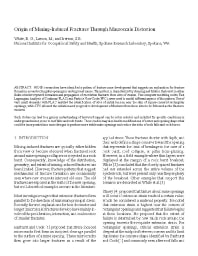Mining Publication: Origin of Mining-Induced Fractures Through Macroscale Distortion
Original creation date: June 2004
Authors: BG White, MK Larson, SR Iverson
NIOSHTIC2 Number: 20026116
Gulf Rocks 2004: Rock Mechanics Across Borders & Disciplines, Proceedings of the 6th North American Rock Mechanics Conference, June 5-10, 2004, Houston, Texas. Report No. ARMA/NARMS 04-569. Alexandria, VA: American Rock Mechanics Association, 2004 Jun; :1-8
NIOSH researchers have identified a pattern of fracture zone development that suggests an explanation for fracture formation around rectangular openings in underground mines. This pattern is characterized by shearing and dilation that result in either faults or in the repeated formation and propagation of en echelon fractures from sites of tension. Two computer modeling codes, Fast Lagrangian Analysis of Continua (FLAC) and Particle Flow Code (PFC), were used to model different aspects of this pattern. Use of very small elements with FLAC enabled the identification of sites of initial tension near the skin of square-cornered rectangular openings, while PFC allowed the initiation and progressive development of fractures from these sites to be followed as the fractures evolved. Such studies can lead to a greater understanding of how roof support can be better selected and installed for specific conditions in underground mines prone to roof falls and rock bursts. These studies may also lead to modifications of comer and opening shapes that could be incorporated into mine designs to produce more stable mine openings and reduce the risks of rock falls and rock bursts.

NIOSHTIC2 Number: 20026116
Gulf Rocks 2004: Rock Mechanics Across Borders & Disciplines, Proceedings of the 6th North American Rock Mechanics Conference, June 5-10, 2004, Houston, Texas. Report No. ARMA/NARMS 04-569. Alexandria, VA: American Rock Mechanics Association, 2004 Jun; :1-8
- Diagnosing and Controlling Moisture-Sensitive Roof in Coal Mines
- Effects of Far-Field Shearing Deformation on Fracturing Around an Underground Opening
- The Introduction of Roof Bolting to U.S. Underground Coal Mines (1948-1960): A Cautionary Tale
- Mistakes, Misconceptions, and Key Points Regarding Secondary Roof Support Systems
- Optimizing Secondary Roof Support with the NIOSH Support Technology Optimization Program (STOP)
- Performance of a Light-scattering Dust Monitor in Underground Mines
- Pillar Design Issues for Underground Stone Mines
- Preventing Injuries Caused by Unrecognized Stone Mine Roof Beam Failures With a Pro-Active Roof Control Plan
- Proceedings: New Technology for Ground Control in Retreat Mining
- Technique to Assess Hazards in Underground Stone Mines: the Roof Fall Risk Index (RFRI)